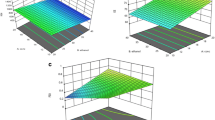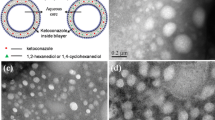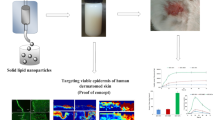Abstract
Liposomal carriers for topical drug delivery have been studied since the 1980s and have evoked a considerable interest. However, the conventional liposomes do not deeply penetrate into the skin and remain confined to the outer layer of SC. In order to increase skin targeting of ketoconazole (KCZ), a hydrophobic broad-spectrum antifungal agent, this study describes novel lipid vesicles as nano-carriers for topical delivery. In this paper, lipid vesicular systems including conventional liposomes (CL), ethosomes, deformable liposomes (DL) and ethanol-containing deformable liposomes (DEL) were prepared as nano-carriers for KCZ, respectively. Sodium dodecyl sulfate [SDS, 0.08 % (W/V)] was used as edge activator for DL and DEL preparation. Characterization of the vesicles was based on particle size, zeta potential, entrapment efficiency and transmission electron microscopy (TEM). In addition, in vitro permeation profile was obtained using vertical diffusion Franz cells by porcine skin. The in vivo accumulation of KCZ was also evaluated in rat skin. Confocal microscopy was performed to visualize the penetration of fluorescently labeled vesicles into skin. All of the lipid vesicles showed almost spherical structures with low polydispersity index (PDI < 0.3) and nano-metric size (no more than 160 nm). The results demonstrated that DEL dramatically improved both in vitro and in vivo skin deposition compared to the CLs (P < 0.05), which was further confirmed by confocal laser scanning microscopy study. In vivo pharmacodynamic studies showed DEL improved antifungal activity against Candida albicans in shorter duration of time. Therefore, based on present study, the novel nano-carrier DEL capable of enhancing skin target effect and forming a micro drug-depot could serve as an effective skin targeting delivery for KCZ as an anti-fungal agent in local therapy.









Similar content being viewed by others
References
Odds FC, Miline LJ, Gentles JC, Hazel Ball E. The activity in vitro and in vivo of a new imidazole antifungal, ketoconazole. J Antimicrob Chemother. 1980;6:97–104.
Custem JV. The antifungal activity of ketoconazole. Am J Med. 1983;74:9–15.
FDA Drug Safety Communications, 2013. FDA limits usage of Nizoral (ketoconazole) oral tablets due to potential fatal liver injury and risk of drug interactions and adrenal gland problems.
Bouwatra JA, Honeywell-Nguyen PL, Gooris GS, Ponec M. Structure of the skin barrier and its modulation by vesicular formulations. Prog Lipid Res. 2003;42:1–46.
Schreier H, Bouwatra J. Liposomes and niosomes as topical drug carriers: dermal and transdermal drug delivery. J Control Release. 1994;30:1–15.
Kirjavainen M, Arto U, Jaaskelainen I, Sobhonen TM, Paronen P, Valjakka-Koskela R, Kiesvaara J, Monkkonen J. Interaction of liposomes with human skin in vitro-The influence of lipid composition and structure. Biochim Biophys Acta. 1996;1304:179–89.
Sinico C, Manconi M, Peppi M, Lai F, Valenti D, Fadda AM. Liposomes as carriers for dermal delivery of tretinon: in vitro evaluation of drug permeation and vesicle-skin interaction. J Control Release. 2005;103:123–36.
Jain S, Tiwary AK, Sapra B, Jain NK. Formulation and evaluation of ethosomes for transdermal delivery of lamivudine. AAPS Pharm Sci Tech. 2007;21:E1–9.
Gillet A, Lecomte F, Hubert P, Ducat E, Evrard B, Piel G. Skin penetration behavior of liposomes as a function of their composition. Eur J Pharm Biopharm. 2011;79:43–53.
Qiu Y, Gao Y, Hu K, Li F. Enhancement of skin permeation of docetaxel: a novel approach combining microneedle and elastic liposomes. J Control Release. 2008;129:144–50.
Song CK, Balakrishnan P, Shim CK, Chung SJ, Chong S, Kim DD. A novel vesicular carrier, transethosome, for enhanced skin delivery of voriconazole: characterization and in vitro/in vivo evaluation. Colloids Surf B. 2012;92:299–304.
Zheng WS, Fang XQ, Wang LL, Zhang YJ. Preparation and quality assessment of itraconazole transfersomes. Int J Pharm. 2012;436:291–8.
Touitou E, Dayan N, Bergelson L, Godin B. Ethosomes—novel vesicular carriers for enhanced delivery: characterization and skin penetration properties. J Control Release. 2000;65:403–18.
Dayan N, Touitou E. Carrrers for skin delivery of trihexyphenidyl HCl: ethosomes vs. liposmes. Biomaterials. 2000;21:1879–85.
Dubey V, Mishra D, Dutta T, Saraf M, Jain NK. Dermal and transdermal delivery of an antipsoriatic agent via ethanolic liposomes. J Control Release. 2007;123:148–54.
Verma P, Pharm B, Pharm M, Pathak K. Nanosized ethanolic vesicles loaded with econazole nitrate for the treatment of deep fungal infections through topical gel formulation. Nanomedicine. 2012;8:489–96.
Li G, Fan Y, Fan C, Li X, Wang X, Li M, Liu Y. Tacrolimus-loaded ethosomes: physicochemical characterization and in vivo evaluation. Eur J Pharm Biopharm. 2012;82:49–57.
Pradhan M, Singh D, Singh MR. Novel colloidal carrier for psoriasis: current issues, mechanistic insight and novel delivery approaches. J Control Release. 2013;170:380–95.
Lee EH, Oh A, Kim YK. Effect of edge activators on the formation and transfection efficiency of ultradeformable liposomes. Biomaterials. 2005;26:205–10.
Oh EK, Jin SE, Park JS, Park Y, Kim CK. Retained topical delivery of 5-aminolevulinic acid using cationic ultradeformable liposomes for photodynamic therapy. Eur J Pharm Sci. 2012;44:149–57.
Cevc G, Blume G. Lipid vesicles penetrate into intact skin owing to the transdermal osmotic gryadients and hydration force. Biochim Biophys Acta. 1992;1104:226–32.
Trotta M, Peira E, Carlotti ME, Gallarate M. Deformable liposomes for dermal administration of methotrexate. Int J Pharm. 2004;260:119–25.
Kombath RV, Minumula SK, Sockalingam A, Subadhra S, Parre S, Reddy RT, David B. Critical issues related to transfersomes-novel vesicular system. Acta Aci Pol Technol Aliment. 2012;11:67–82.
Honeywell-Nguyen PL, de Graaff AM, Groenink HW, Bouwstra JA. The in vivo and in vitro interactions of elastic and rigid vesicles with human skin. Biochim Biophys Acta. 2002;1573:130–40.
Honeywell-Nguyen PL, Gooris GS, Bouwstra JA. Quantitative assessment of the transport of elastic and rigid vesicle components and a model drug from these vesicle formulations into human skin in vivo. J Invest Dermatol. 2004;123:902–10.
Honeywell-Nguyen PL, Bouwstra JA. Vesicles as a tool for transdermal and dermal delivery. Drug Discov Today. 2005;2:67–74.
Liu D, Hu H, Lin Z, Chen D, Zhu Y, Hou S, Shi X. Quercetin deformable liposome: preparation and efficacy against ultraviolet B induced skin damages in vitro and in vivo. J Photochem Photobiol B. 2013;127:8–17.
Gupta PN, et al. Non-invasive vaccine delivery in transfersomes, niosomes and liposomes: a comparative study. Int J Pharm. 2005;293:73–82.
Van den Bergh BAI, et al. Elasticity of vesicles assessed by electron spin resonance, electron microscopy and extrusion measurements. Int J Pharm. 2001;217:13–24.
Bronaugh RL, Stewart RF, Congdon ER. Methods for in vitro percutaneous absorption studies II. Animal models for human skin. Toxicol Appl Pharmacol. 1982;62:481–8.
Sullivan TP, Eaglstein WH, Davis SC, Mertz P. The pig as a model for human wound healing. Wound Repair Regen. 2001;9:66–76.
Eskandar NG, Simovie A, Prestidge CA. Nanoparticle coated submicron emulsions: sustained in vitro release and improved dermal delivery of all-trans-retinol. Pharm Res. 2009;26:1764–73.
Panchagnula R, Desu H, Jain A, Khandavilli S. Effect of lipid bilayer alteration on transdermal delivery of a high-molecular-weight and lipophilic drug: studies with paclitaxel. J Pharm Sci. 2004;93:2177–83.
Howes D, Guy R, Hadgraft J, Heylings J, Hoeck U, Kemper F, et al. Methods for assessing percutaneous absorption: the report and recommendations of ECVAM Workshop 13. Altern Lab Anim. 1996;24:81–106.
Uchida K, Tanaka T, Yamaguchi H. Achievement of complete mycological cure by topical antifungal agent NND-502 in guinea pig model of tinea pedis. Mircrobiol Immunol. 2003;47:143–6.
Tatsumi Y, Yokoo M, Arika T, Yamaguchi H. In vitro antifungal activity of KP-103, a novel triazole derivative, and its therapeutic efficacy against experimental plantar tinea pedis and cutaneous candidiasis in guinea pigs. Antimicrob Agents Chemother. 2001;45:1493–9.
El Maghraby GM, Williams AC, Barry BW. Interactions of surfactants (edge activators) and skin penetration enhancers with liposomes. Int J Pharm. 2004;276:143–61.
El Maghraby GM, Williams AC, Barry BW. Skin delivery of oestradiol from deformable and traditional liposomes: mechanistic studies. J Pharm Pharmacol. 1999;51:1123–34.
El Maghraby GM, Barry BW, Williams AC. Liposomes and skin: from drug delivery to model membranes. Eur J Pharm Sci. 2008;34:203–22.
El Maghraby GM, Williams AC, Barry BW. Interactions of surfactants (edge activators) and skin penetration enhancers with liposomes. Int J Pharm. 2004;275:143–61.
Prausnita MR, Langer R. Transdermal drug delivery. Nat Biotechnol. 2008;26:1261–7.
El Maghraby GM, Williams AC, Barry BW. Can drug bearing liposomes penetrate intact skin? J Pharm Pharmacol. 2006;58:415–29.
Touitou E, Godin B, Dayan N, Weiss C, Piliponsky A, Levi-Schaffer F. Intracellular delivery mediated by an ethosomal carrier. Biomaterials. 2001;22:3053–9.
Li G, Fan C, Li X, Liu Y. Preparation and in vitro evaluation of tacrolimus-loaded ethosomes. Sci World J. 2012;2012:1–6.
Valenta C, Janisch M. Permeation of cyproterone acetate through pig skin from different vehicles with phospholipids. Int J Pharm. 2003;258:133–9.
Verma DD, Verma S, Blume G, Fahr A. Particle size of liposomes influences dermal delivery of substance into skin. Int J Pharm. 2003;258:141–51.
Acknowledgments
This research was supported partially by the National Basic Research Project (2014CB932200) of the MOST for financial support.
Conflict of interest
The authors report no declarations of interest.
Author information
Authors and Affiliations
Corresponding authors
Rights and permissions
About this article
Cite this article
Guo, F., Wang, J., Ma, M. et al. Skin targeted lipid vesicles as novel nano-carrier of ketoconazole: characterization, in vitro and in vivo evaluation. J Mater Sci: Mater Med 26, 175 (2015). https://doi.org/10.1007/s10856-015-5487-2
Received:
Accepted:
Published:
DOI: https://doi.org/10.1007/s10856-015-5487-2




